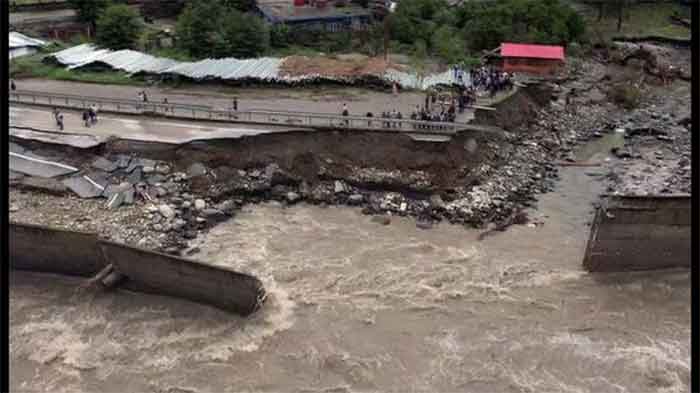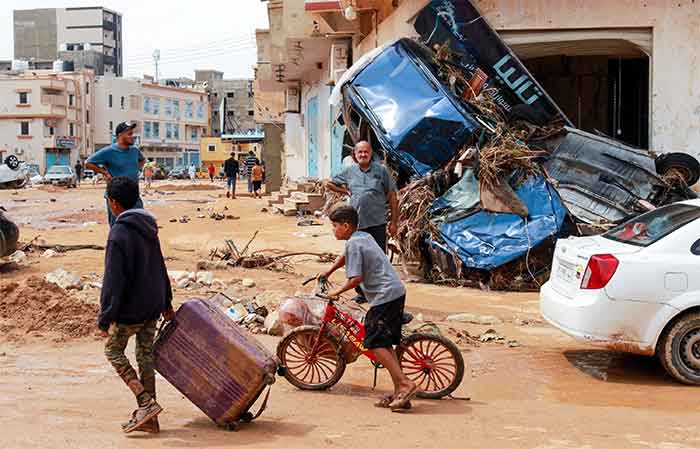
Himachal Pradesh has suffered heavier damage during this monsoon season than in any recent year that most people here can recall. While over 300 people have died and economic damage has been put at Rs. 12,000 crore till early September, given the extreme nature of the devastation the mortality figure could have been much higher but for the noble efforts of many brave rescuers.
While houses of several people were shattered and destroyed, even more numerous are the people whose houses are endangered now—damaged, with cracks or threatened by further landslides—and so they have to stay in tents or seek temporary refuge in religious places or with their relatives. As a report in The Times of India titled ‘Landslides and sinking mountains turn 122 villages of Solan unsafe’ towards the end of August stated—“Rain-triggered landslides and sinking of mountains have rendered over 122 villages of Solan district unsafe and displaced 8500 inhabitants who have been moved to safer locations by the district administration. The landslides have led to the damaging of 1200 houses in Himachal Pradesh’s Nalagarh, Kasauli and Arki sub-divisions.” Another report in Amar Ujala newspaper ( 3 September ) stated that in Doon area of Baddi industrial zone 112 houses were damaged and 45 have developed cracks. These families are still living with others despite a month having passed. However these are the more accessible areas, not the worst affected areas. The situation is much more serious in the worst affected Mandi-Manali zone and in the very remote areas from where news may not travel so fast as from the more accessible places and the tourist resorts. There have been reports of people including women, children and the elderly having to walk on very dangerous paths where a single wrong step may mean serious injury or even death by drowning in the rivers below. The needs in terms of repairing roads, bridges and other essential infra-structure are huge.
In view of the massive damage caused there is a clear case for the central government to be very generous with its help for the state and more resources for providing relief and rehabilitation should be rushed here.
While the need for stepping up in a big way the relief, repair and rehabilitation work is the biggest priority today, there is also an urgent need for re-defining development, for a new understanding of development so that it is in tune with the fragile geological and sensitive ecological conditions of a very young (in geological terms) and unstable mountain region whose greater part is exposed to high seismicity. In this context recent development experiences of the state have been disastrous. The most disastrous and destructive projects have been initiated in the name of development and tourism. What has been done in the name of attracting tourists may ultimately prove so destructive as to scare them off. The beautiful heritage railway track from Kalka to Shimla has suffered more destruction this time than ever before, while the size of the boulders brought by the very frequent landslides on the Kalka-Shimla highway is scary. Some officials now say so much harm occurred because of the soil conditions, but they did not think about the soil when they were cutting thousands of trees mercilessly for too much widening of road which was not really needed, or when they were cutting the hills vertically for the same purpose which was likely to bring disaster sooner or later.
Now there are many allegations and even a legal case against the way in which the Parwanoo Solan highway has been badly mishandled, involving criminal negligence, although till some time back this was being showcased as a big achievement. It appears that the most obvious precautions have been ignored by the National Highway Authority in many Himalayan four-lane projects, causing huge harm to people and environment. However earlier when attention was drawn to this even by eminent persons, they were simply labeled by the authorities as anti-development. While the Chief Minister has done well to draw attention to the serious mistakes of highway authorities which resulted in a narrowing of the flow of the Beas river, his suggestion that more tunnels are needed in the Parwanoo-Dharampur stretch or that more tunnels can help to avoid problems that have been created are not at all based on the factual situation.
Flash floods caused by dams are a reality now, and the government is itself concerned about the dam management in difficult times after the havoc caused recently. 21 dams are reported to have violated safety norms.
It appears that apart from the large scale known felling of trees for dam and highway projects, there has been illegal felling too, and a lot of boulders of these trees flowing with the torrential flood war added to the immense destruction.
While many experts have talked about the man-made factors behind the recent disasters, there is still no sign that the development model will be changed in any significant ways. On the contrary we are still seeing headlines like ‘Fresh muck dumping in Bilaspur district’ (The Times of India September 1) and “ After rain disaster, Shimla sees illegal felling of trees’ (The Tribune). This is really sad, and till there is a clear re-defining of what constitutes development in such fragile and sensitive zones, the people of Himachal will never be safe from such high-risk, highly destructive situations as seen this year, and this is likely to be all the more true with worsening climate change.
Bharat Dogra is Honorary Convener, Campaign to Save Earth Now. His recent books include Planet in Peril, Man over Machine and A Day in 2071.














































